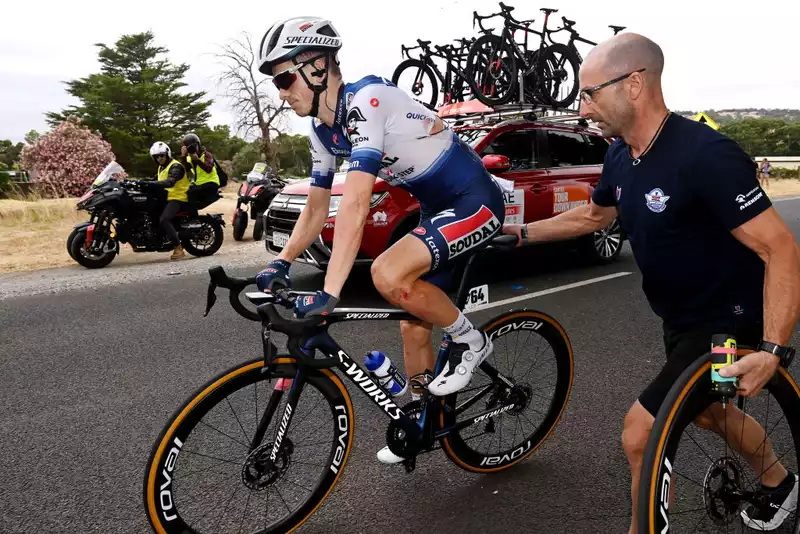James Knox complained of a conflict between UCI rules and rider safety after he was involved in a crash 55km from the end of stage 1 and was disqualified from the Tour Down Under for drafting behind a team car.
Briton James Knox had been checked for concussion after a series of crashes in the peloton during the stage. However, the UCI commissioner during the race disqualified him for drafting a team car to return to the peloton.
Knox explained on Twitter Thursday morning the sequence of events that led to his disqualification during the 150km stage in Tanunda, saying that the UCI commissaires prevented him from returning to the peloton after two stops.
"As some of you know, I was disqualified on the first stage of the Tour Down Under. I crashed hard with 55km to go and needed to be checked by the team doctor to make sure I didn't have any broken bones and more importantly, no concussion," Knox wrote.
"After re-entering the race, I realized that my handlebar was broken and I had to stop again and switch to a spare bike. The race situation settled down after the intermediate sprint, but the commissaire refused to let me stay behind the machine for more than a couple of kilometers"
.
"I have no idea of the exact reason for this. My only hope was to get back to the back of the convoy, or at the very least, back to the other crashed riders in front of me."
"I traveled all over the world to participate and watched from the back as other fallen riders stayed behind their cars to get back into the race, hoping to continue the race that still had four days left. After this I have to accept responsibility for the mistake I made."
[16Knox further said that he was left to drive alone in the convoy with no information about the race conditions, and that he was then drafted by several cars to try to get back into the race.
He noted that given the situation he was in, he was effectively forced to choose between getting tested for a possible concussion or getting back on the bike as soon as possible to resume racing.
"I was drafted for several kilometers by two soigneur cars leaving the final feed without being given any information about time differences or time cuts," Knox continued.
"I was seen doing so and was disqualified. If cycling takes serious steps to preserve the welfare of its riders, commissaires should not punish riders for remaining after a crash to be properly assessed.
"The actions they took immediately after the crash clearly indicate that I would have been better off reboarding immediately without being properly assessed. The rules for getting back into the convoy are very tricky, but I feel this is a clear example that I wasn't trying to use the car to my advantage and that if I hadn't crashed I wouldn't have been in that situation."
Cycling's concussion protocol has been in place since the end of 2020, a long overdue measure in a sport where riders can easily suffer head injuries in a crash. Earlier that year, a visibly unsteady Romain Bardet was running a 90-km race after crashing on stage 13 of the Tour de France and was later diagnosed with a small cerebral hemorrhage.
UCI guidelines require that team staff, other than riders and medical personnel, be familiar with a "pocket guide" on how to spot signs of potential brain injury.
Knox's plight raises the possibility of a conflict in UCI regulations between the need to check injured riders and the rules that prevent riders from drafting into cars to return to the race, and communication between UCI commissaires during live racing line is being questioned.
Current UCI regulations prohibit "taking refuge behind the slipstream of a vehicle or using the slipstream" and in "serious cases, repeated violations, aggravating circumstances, or when the violation is advantageous," riders and drivers are subject to fines and class classification penalty and disqualification.
In response to Knox's statement, several riders took to Twitter to support the Soudal Quickstep climber.
Ineos Grenadiers veteran Luke Lowe noted that the rider had to make a "very risky" choice given what happened to Knox.
"So what the UCI is saying here is very dangerous, Rowe wrote. 'If you crash, go straight back on the bike without inspection. Otherwise, you could be eliminated from the race." Instead of "getting properly inspected, following protocol, and then getting assistance to return to the peloton.
Meanwhile, Oliver Naessen (AG2R Citroen) called the decision a "joke" and said that in a situation like Knox's, he should be allowed to return to the peloton.
"Such a joke ...... Proper inspections take time. Once the green light is given to restart, they should at least be allowed to return to the final group. Drafting, not hanging from a car." It's a shame that on the other side of the world we get DQ'd for this."
Cycling News has reached out to the UCI for comment.
.

Comments